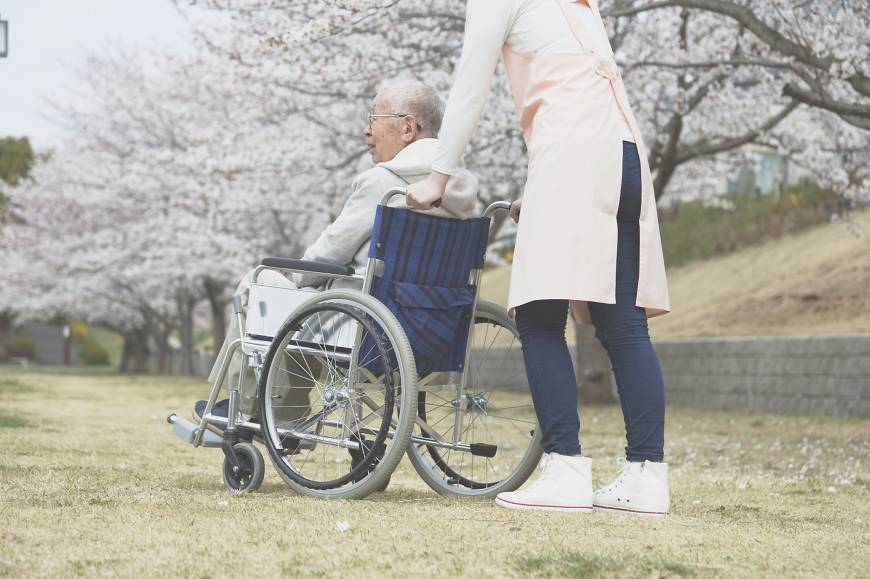“Caregiving is such a difficult job. It not only requires skills, but you need to be passionate about it,” quoted by one of the filipina caregivers in japan.
The Health, Labor and Welfare Ministry estimates the nursing care industry will face a shortage of about 300,000 caregivers by 2025, but the EPA framework, which targets qualified nurses from Indonesia, the Philippines and Vietnam, is not enough to resolve the shortage.
To lure more foreign nurses, the administration of Prime Minister Shinzo Abe is pursuingtwo other avenues: expanding a state-sponsored foreign internship program and creating a new visa status for foreign caregivers.
At a glance, this may seem like good news for non-Japanese looking for job opportunities in the nursing industry of the world’s most rapidly graying nation.
But opponents are especially critical about expanding the maligned internship program, saying it is simply a way to exploit cheap foreign labor to make up for Japan’s labor shortage, including nurses and caregivers.
Instead, Japan should implement drastic measures to make it more accepting of immigrants. These would range from ensuring safe working environments to providing sufficient language instruction so immigrants can become a stable part of the workforce in the long term, they say.
The government plans to add nursing care to a list of about 70 professions in the trainee program. Nursing internships would last a maximum of five years. If included, nursing care will become the first profession under the decades-old program requiring person-to-person service, contrasting sharply with the more traditional fields of agriculture, manufacturing and construction.
Aspiring caregivers will be required to have Japanese proficiency of N4 or higher under the five-tiered Japanese-Language Proficiency Test. While some describe N4, the second-lowest level, as appropriate for trainees, critics say it is so low that it “severely compromises their caregiving duties,” according to the Society for Teaching Japanese as a Foreign Language. The test’s website lists N4 as the “ability to understand basic Japanese.”
The trainee program, launched in 1993, has long been slammed as a hotbed of exploitation. Rife with low pay and unpaid overtime, some have said it is tantamount to forced labor and human trafficking. Fed up with the subpar wages, a record 4,851 of the “interns” walked away from their employers in 2014, the Justice Ministry said.
“The thing about the traineeship program is that it’s essentially a system meant to maintain Japan’s global competitiveness at the expense of the well-being of foreigners,” said Wako Asato, an associate professor of Graduate School of Letters at Kyoto University.
To resolve the issue, a government-sponsored bill calls for forming an oversight body that would have the authority to conduct on-site investigations at firms accused of abuse. The body would also set up a system that lets interns file complaints. The bill stipulates that participating employers would face prison terms of one to 10 years for abusing or threatening trainees.
But critics such as Toshihiro Menju, managing director at the Japan Center for International Exchange think tank in Tokyo, say the program’s culture of corruption runs so deep that no major improvement appears in the offing.
If caregivers are added to the internship program, he said, they are likely to encounter poor working conditions.
“No matter what oversight body is created, the law can’t stop employers from viewing the foreigners as a source of the cheapest labor possible and secretly engaging in wrongdoing. We need to change their fundamental mindset,” Menju said.
Meanwhile, employers are reluctant to hire foreign trainees who, unlike those in the EPA framework, lack nursing qualifications.
While the EPA framework is open exclusively to those who have qualified as professional nurses in their home countries, the internship program imposes no such prerequisites, meaning some interns may be clueless about what it means to take care of the elderly, Kyoto University’s Asato said.
“If such individuals are invited to work at nursing homes, it is sure to put operations there in disarray,” Asato said.
One industry insider who runs a nursing home in Tokyo stated his fears more directly.
“I don’t think I will hire anybody from the internship program as a staffer, because I don’t want to compromise the safety of our patients,” said the man, who asked to remain anonymous.
Unlike the traineeship program, the proposal to create a new visa status for non-Japanese caregivers or exchange students who have studied the subject in colleges or vocational schools, is targeted at those with proper knowledge.
The new visa status essentially allows such people to stay and work as caregivers in Japan after graduation. Like other working visas, the new status is good for a maximum of five years and is renewable, granting hopefuls the potential to settle in the country, a Justice Ministry official said.
However, with its rigid requirements, the new visa status is unlikely to attract more than a handful of candidates. Applicants would have to pass the national nursing care exam in Japanese to receive the visa.
For a nearly homogeneous nation like Japan, absorbing a large chunk of non-Japanese into the workforce poses a challenge, and caregivers under the EPA framework may pose a litmus test on the issue.
As part of their preparations for the national nursing care exam, they take Japanese lessons arranged by the facility for a combined six hours a week. They live together in an apartment, likewise arranged by their employer, just a stone’s throw from their workplace. After being stripped of taxes and rent, their monthly take-home pay is typically around ¥100,000, which they said is triple the average in the Philippines.
Although they admit their motivation is partly economic, they also voice hope they will be able to continue working in Japan in the years to come.
But to ensure a stable and skilled workforce from overseas, Japan must first come up with a framework that encourages long-term settlement, not a patchwork of expanding internship programs, said Menju of the Japan Center for International Exchange.
“By expanding the traineeship program and creating a new visa status, Japan is essentially opening its gate to immigrants,” Menju said. “If Japan is going to accept immigrants, it needs to create an environment where they can adjust to Japanese society.”
This means ensuring access to language lessons, drafting a law to stipulate their rights and obligations, and making sure that if they settle and marry in Japan, their descendents will also be welcome, Menju said.
“Japanese people need to change their perspective,” he said. “Avoiding public debate on the issue would only cause problems in the future.”
The Japan may have the idea of hiring more foreign caregivers and nurses to outgrow their increasing demand of healthcare workers but the question is, are they willing to accept the foreigners as one of their own or will this idea race another issue in terms of racial discrimination?
When will this caregiver/nurses opportunity become an open public opportunity for the said countries was not yet decided but it has been started years ago, little by little who knows? Japan might be one of the countries like US or Middle-east to provide better jobs for unemployed qualified healthcareworkers with competitive salaries and benefits that could aid in uplifting the lives of some of our fellow filipinos?
(c)japantimes,onlinenews
























You must be logged in to post a comment.